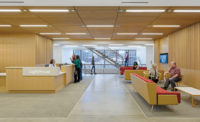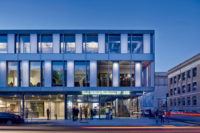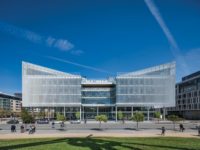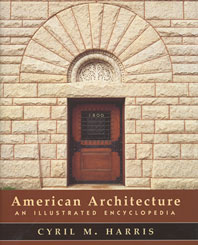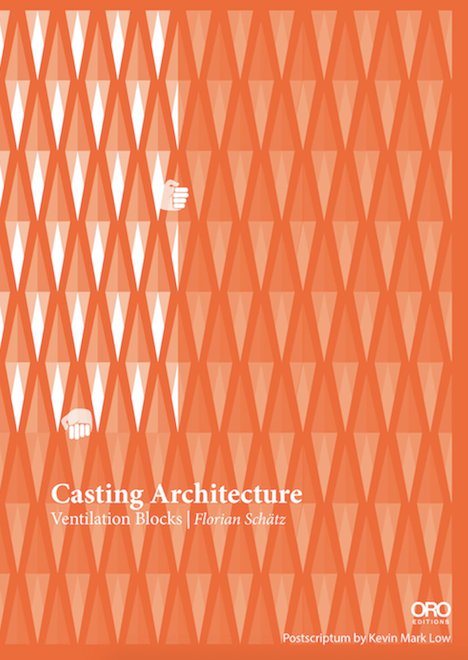Mark Cavagnero readily admits that his personal relationship with Catholicism ended after he attended a parish school as a child in Connecticut. So, when he received a request to interview for a commission to design a student chapel for a Catholic high school in the San Francisco Bay Area, he wasn’t sure he was up to the task.
“My faith had wavered, to say the least,” Cavagnero recalls. But then he began to think about the intersection of spirituality and architecture in a broader way—as “idealized space that could offer empathy, with room for contemplation that may, or may not, include prayer.”
Additional Content:
Jump to credits & specifications
That impulse is now embodied in a small structure of concrete and glass at the entrance to St. Mary’s College High School, in Albany, California. Unapologetically modern yet suffused with tranquil warmth, it serves as a symbolic portal to the campus, as well as an open refuge for students seeking inspiration or solitude, often at conflicted times in their lives.
Unlike other buildings on the 12.5-acre campus, most of which were built as needed during the past 30 years and have a vague air of Mission Revival style, the 4,400-square-foot chapel makes a striking first impression. Just inside the campus’s entry gate, off a shaded street of single-family homes, a rectangular concrete “ steeple” rises, its back pitched and its eastward face inset with glass that is divided into quarters by a thin metal cross. Around and behind the tower, like rectangular ridges beneath a mountain peak, the building’s lower sections hold the chapel and a small sacristy.
The religious imagery is obvious. But the steeple, a great, hollowed-out light shaft, also allows morning sunlight to slice into the sanctuary, illuminating the altar, where a priest addresses the pupils, who often gather for brief talks or services before classes begin. Later in the day, when a student might come on his or her own, the altar fades into the shadows while the chapel is lit from behind.
“It seemed important to break the room down into different scales,” explains Cavagnero, who in 2015 won the coveted Maybeck Award from the AIA California Council. “I was thinking about what it would be like if I was going through a moment of stress in my life. I’d want a space where I could think and brood and wonder.”
While the morning light is clean and direct, the afternoon sun—entering through floor-to-ceiling glass panels at the chapel’s southwest corner—fills the sanctuary with a diffused glow. A clerestory window of frosted glass, tucked along the north edge of the space, evens out the illumination without calling attention to itself.
The pews are white oak. So are the slats along the chapel’s southern wall—positioned not only to direct light toward the front of the chapel, but also to form a screen that blocks distracting outside views from the pews. The floor is smooth Alabama limestone. The vertical plane behind the altar is the same stone, but split-face, and the other walls are of white Portland cement. “The best way to make a space that’s visually and spiritually quiet,” suggests Cavagnero, “is to use as few elements as possible, and to keep them under control.”
The architect was less successful, however, in his quest to make the chapel feel like a sanctuary entirely apart from the hectic commotion of a high school with more than 600 students, and other challenging conditions. Though the site parallels a creek lined with tall redwood trees—hints of nature that filter into the chapel and its courtyard—it’s also bordered by a service road. The tower, meanwhile, faces a wide asphalt roadway and a utility building.
To counter these encroachments, the design moves the chapel entrance to the site’s rear, in a small courtyard, reached from the east by a pathway, flanked by Cavagnero’s building on one side and, on the other, by a concrete wall that drops from 8 to 4 feet high as it nears the courtyard. When the three Japanese maples that are part of Andrea Cochran’s landscape design grow in, the sense of passage should feel more natural. It’s an imaginative response to a challenging site, but a self-consciously choreographed one, as well.
Once inside the chapel, though, emotional resonance emerges in the way clean details are infused with higher purpose. The choice of the chalky-white Portland cement for the walls—its superlative quality being an expense that Cavagnero defended from value engineering—brings a subdued luster to a material that students and staff might otherwise dismiss as cold and stark. There’s delicacy in the tall cross within the tower. The light in the chapel, diffused and entering from all sides, is at once comforting and solemn.
In the past, when religious faith was unquestioned, churches were designed to awe believers with majestic force. We live in a different, less doctrinaire age—in which many people choose to set traditional religion aside, or to draw on a variety of different philosophies and creeds. This is what St. Mary’s chapel responds to, glowing with an offer of sanctuary and solace, whatever form one’s beliefs might take.
CreditsArchitect: Mark Cavagnero Associates 1045 Sansome Street, Suite 200 San Francisco, CA 94111 415.398.6944
Personnel in architect's firm who should receive special credit: Mark Cavagnero, FAIA John Fung, LEED AP Ellen Leuenberger, RA, LEED AP Andy Lau Mark Jewell, AIA, LEED AP BD+C
Engineers: Civil: CSW|ST2 Structural: Mar Structural Design Mechanical: Costa Engineers, Inc. Electrical: O’Mahony & Myer Plumbing: Costa Engineers, Inc.
Consultants: Landscape: Andrea Cochran Landscape Architecture Acoustics: Charles M. Salter Associates, Inc. Litergical Consultant: Archdiocese of Omaha Project Management: Cushing Associates Specifications: Stansen Specifications
General contractor: Roebbelen Contracting, Inc.
Photographers: Joe Fletcher, Henrik Kam
Client: Saint Mary’s College High School
Size: 4,400 square feet
Cost: withheld
Completion date: September 2018 |
SpecificationsExterior Cladding Metal/glass curtain wall: Kawneer Curtainwall and Storefront Systems Moisture barrier: Grace Construction Products Curtain wall: Kawneer Other cladding unique to this project: White Concrete
Roofing Built-up roofing: Johns Manville TPO
Glazing Skylights: Velux:
Doors Metal doors: Minton Door Company Wood doors: Minton Door Company, Eggers Industries Special doors: Nanawall
Hardware: CRL Blumcraft, Ives, Jackson, LCN, Pemko, Rixon Specialty Door Control, Schlage, Zero International, Assa Abloy
Interior Finishes Acoustical ceilings: Eurospan Ceiling System Cabinetwork and custom woodwork: American White Oak Special surfacing: Corian Special interior finishes unique to this project: Wood at furniture, paneling, doors: American White Oak Stone: Silver Shadow Alabama Limestone honed at floor, split face at Altar Wall
Furnishings Fixed seating: Pews: New Holland Church Furnishings
Lighting: B-K Lighting, BEGA, Volt Lighting Group, Juno Lighting Group, Amerlux, Philips, Focal Point LLC, Axis Lighting, Vode Dimming system or other lighting controls: Lumenpulse
Energy Add any additional building components or special equipment that made a significant contribution to this project: Operable windows to support natural ventilation |











